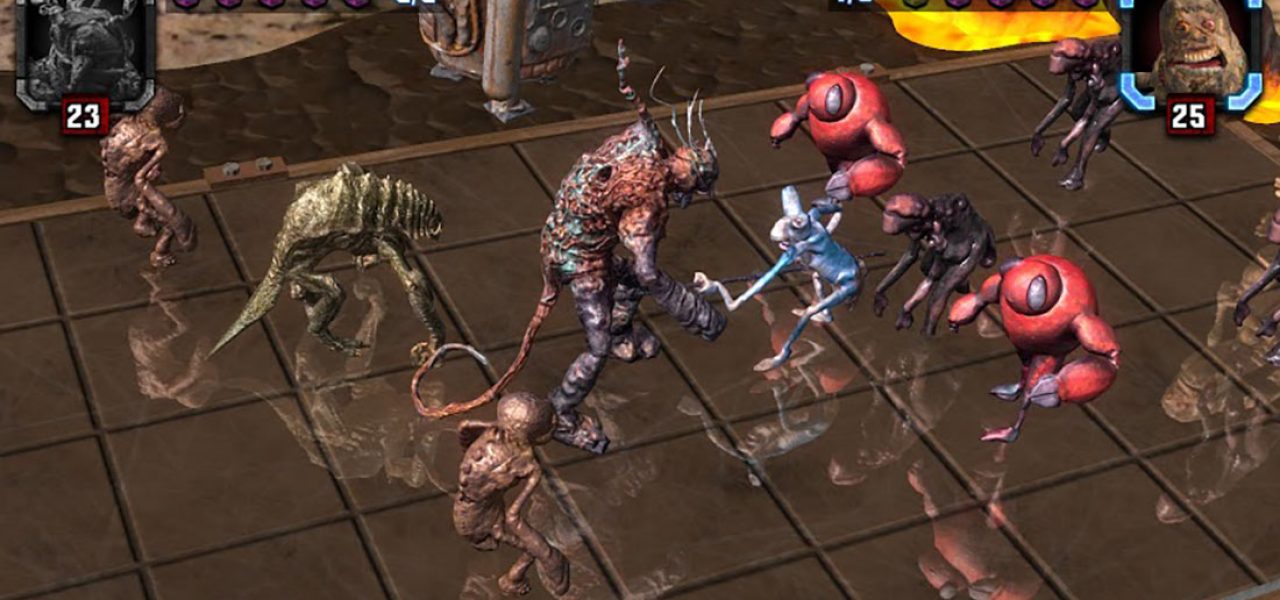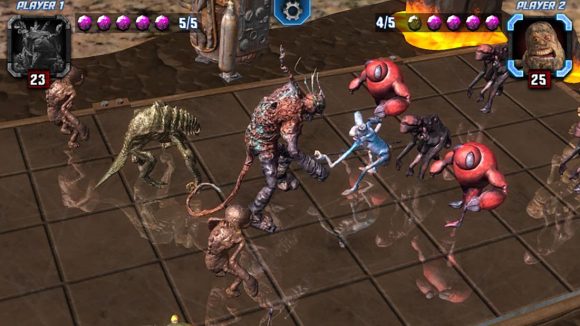

Stop Motion Master Phil Tippett Brings Hand-Made Vitality to Augmented Reality Holo-Chess Game
Few names resonate as loudly as Phil Tippett in the effects and animation industry. The visual effects supervisor is probably best known for helping to create several of the most iconic sequences in some of the most iconic movies of all time.
One of those sequences is the stop motion animated hologram chess game aboard the Millennium Falcon in Star Wars: A New Hope, which Tippett even briefly revisited for The Force Awakens (see behind-the-scenes below). It’s a game die-hard fans have perhaps dreamed of playing for real ever since its first appearance.
Now Tippett and his team of artists at Tippett Studio are using their creature design and stop motion chops in a new way that might just make playing a form of holo-chess possible. The artists have lent their skills and 30 years of monster creations to an augmented reality (ar) board game called HoloGrid: Monster Battle. Cartoon Brew spoke to Tippett Studio, including Phil Tippett, about how the game is being made using the technique of photogrammetry.
Before we explore the board game, let’s look back at Phil Tippett’s stellar career. In addition to the chess sequence in Star Wars, Tippett also helped animate the Tauntans on Hoth in TheEmpire Strikes Back, and puppeteered the Rancor underneath Jabba’s Palace in Return of the Jedi. If that’s not enough kudos, Tippett and his studio also contributed to Robocop, Jurassic Park, Starship Troopers, and The Twilight Saga.
Tippett was famously brought on in Jurassic Park to realize the dinosaurs in stop motion until director Steven Spielberg saw the potential of computer generated imagery and CG animation. That forced Tippett to adopt the digital effects world, where he flourished with a definitive raw style and an ongoing love for the old-school practical stop motion techniques.
As a company, Tippett Studio has ridden the digital wave but, as with many other visual effects studios in this often tumultuous industry, has also constantly had to find new areas to work in. This ar board game is just one example of that extension of the main visual effects portfolio. The studio is partnering with Happygiant, an independent game developer founded by veterans of LucasArts, ILM, Hasbro, and Pileated Pictures.
How Hologrid works
Hologrid: Monster Battle is envisaged as a combination trading card and ar game where players will sit across from each other with their mobile devices. The mobile ar application creates a ‘holographic’ chess board in between the players, who can use the characters on the playing cards to battle one another.
It’s those characters and the way they have been brought to life that make the game different than almost any other trading card playset. That’s because the creature designs come directly from real life figures Phil Tippett has made over the years in the industry. They’re actual models that have been digitized into 3D models. “They wanted ‘Phil Tippett’ creatures and I had a bunch of them in the corral,” Tippett told Cartoon Brew. “So we let ‘em out.”
In fact, all over Tippett Studio’s Berkeley, California complex there are remnants of puppets and sculptures from past projects, some 30 years old and others from more recent endeavors such as Tippett’s independent Mad God stop motion project. Happygiant specifically wanted to include a very hand-made feel to the creatures in HoloGrid, making these pre-exisiting puppets and sculptures a perfect fit for the game.
To get them into a format that could be used in the ar component, Tippett Studio devised a photogrammetry pipeline for photographing and digitizing the models (ranging in size from two to sixteen inches) and many of which had painstaking hand-crafted paint jobs.
The photogrammetry involved taking hundreds of photographs with a Canon 5D DSLR of the models on a rotating base. At each 10 degree rotation a picture was taken. “We shot three passes of rotations,” explained Tippett Studio visual effects supervisor Chris Morley. “One with the camera level with the creature, one raised 30 degrees pointing down, and then one with the camera higher and pointed up.”

The resulting stills were fed into Agisoft’s Photoscan, a now ubiquitous tool for photogrammetry that delivers a high fidelity 3D model with geometry and color detail. All of Tippett’s hand-painted, torn-looking, and roughed-up textures came through in the Photoscan models, a key part of what the monsters would eventually look like for the game. Happygiant is separately responsible for the monster animation, app creation, and building of the physical playsets.
Preserving those hand-made aspects of puppets and sculptures with photogrammetry was always Happygiant’s intention and proved to be a nice way to bridge the practical and digital divide that Tippett Studio had itself gone through. “Some of the guys think that I have a very distinctive kind of style, which I don’t quite recognize myself, but that seemed to be what was resonating with people,” acknowledged Tippett.
Still in development
Hologrid: Monster Battle isn’t quite a reality just yet. There is a beta version, but Tippett Studio and Happygiant have recently finished raising over $100,000 in a successful Kickstarter campaign that will support the development of a fully packaged game set available later this year (at first for use with mobile apps, with the possible extension at a later date to vr and ar headsets and consoles).

There’s certainly much love out there for Tippett’s weird and wonderful creations over the years—right now it remains to be seen whether that can translate into the nuanced world of trading card games. In any event, the stop motion master eyes a glimmer of hope in restoring a hand-made feel to effects and animation in general after his experience with the Hologrid project. “The amazing thing about photogrammetry is that it brings back people making things with their hands, and that’s a great thing,” he said.
Hologrid: Monster Battle is to be released later in 2016. You can pre-order the game at hologridmonsterbattle.com.

.png)